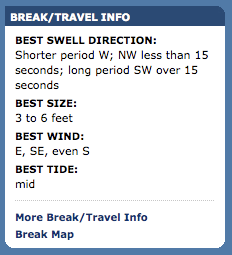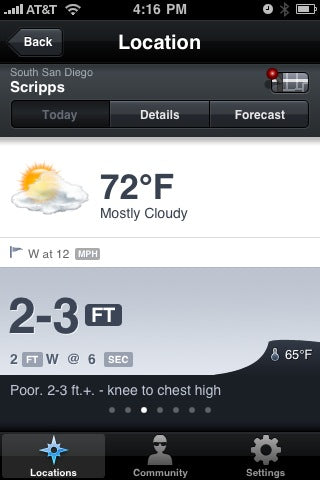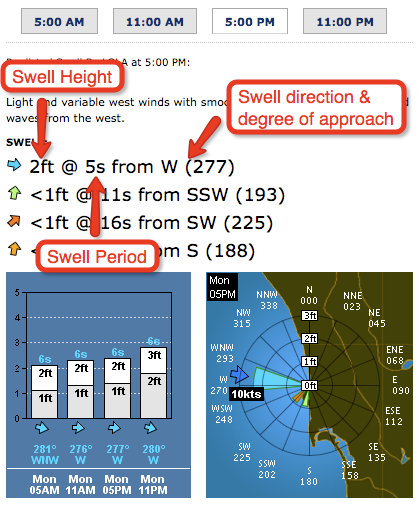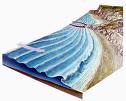Reading a Surf Report and Knowing the Conditions Equals Great Waves
SURF REPORTS FOR DUMMIES
Lets say you recently purchased a surfboard or maybe you’ve been surfing for a little while but you just go, regardless of what the waves look like. A tool that can immediately affect the quality of your experience is knowing what factors play into wave conditions. Looking at some of the better online surf reports is always going to be helpful, but if you don’t quite understand the information they are giving you, you still won’t be able to fully take advantage of the best conditions.
Here's a list of the factors you'll need to consider:
- Wave size
- Swell direction
- Wind direction
- Wind strength
- Ocean topography
- Tidal info
- Water temp
- Time of day
- Sunrise
- Sunset
If you’re just beginning to surf and feel a bit overwhelmed by all the information available and really just want to go surf and not worry about how good the waves are, the most important thing to pay attention to is wave size and height. The strength of the wave is going to play a big part in how easy or difficult it will be for you to catch waves. Tall, strong waves can be intimidating, so it might be best to pick and choose your battles by looking at the surf report before you venture out. Or, if you’re one of those people who feel that the bigger the waves the better, you should still check the report, if only to see what board you should bring to best suit your hard-charging style!


On a side note, a day of big waves doesn’t mean that you have to give up on improving your surfing! There are many other activities you can work on such as core and endurance exercises, as well as improving your balance and lung capacity on those days where its just too big for you, or when its totally flat out. Keep an eye out for future Degree 33 articles highlighting these other topics! For those of us who are looking to find the best waves available at any given time or day, we can go a bit more in depth with what can help determine wave conditions. For the most part, online reports such as those on www.Surfline.com, www.SwellInfo.com, or even the Surf Report iPhone ap (powered by Surfline.com) will summarize most of the pertinent information for you. However, you also need to know a bit about swell and wind direction, wave height, break type, and tide cycles in order to know where to go and when.
Wave Size & Swell Direction
Swell direction is super important in knowing how well a swell will hit your favorite spot. Lets say your secret spot is a west-facing beach break but the next expected swell is coming from the south west; This basically just means that the waves are going to hit the beach at an angle, producing a different wave shape than if they hit directly from the west. The wave direction that you want is going to vary from spot to spot so its smart to check your break when different swells are hitting it to see what effect it has. Wave size can be determined obviously through the average size range given on most surf reports, but a clearer picture of what the waves will actually look like can be seen by looking at the data given from local offshore buoys. Buoys measure the intervals between waves and what size those waves are. If you check a report and the buoy is saying that its 3ft. at 5 seconds, it probably isn’t going to be very big, or very consistent. The amount of time between waves can be helpful in determining how big a swell ends up being because it shows you how long the wave has had to build. So, a swell of 3ft. at 20 seconds is going to be significantly larger than one that has a 4 to 5 second interval. Also, a shorter interval can indicate that lots of small insignificant waves are going to result in inconsistent, sloppy surf. A large swell size with a long interval means that the waves are most likely going to be massive, so you’ll probably want to keep your eye out for that.

Wind Direction & Strength
Wind plays a major role in both creating and changing the form of waves. Waves are mostly created by forceful winds from large storms offshore, but they can affect the quality of waves almost any time you go out. Wind direction is the main thing you want to pay attention to when looking at the surf report. An onshore wind is one that blows directly at you when you are looking out at the ocean, or as the name suggests, a wind that blows from the ocean onto the shore. This kind of wind is not good for wave form and generally deteriorates conditions quickly by knocking waves down and crossing them up. This results in choppy, churning surf that is difficult to manage. A great website that gives you wind direction and strength is www.SailFlow.com.

Another type of wind is known as offshore wind and it is usually considered the next best thing to having no wind at all. An offshore wind is one that blows from the shore out to sea and it can help improve conditions. It holds waves up and allows them to really build before they break, creating hollow, fast waves. Many people enjoy the visual effect that an offshore wind creates, as spray blows away from the top of the waves as they break. Any other wind direction is going have a different affect on the waves depending on its strength. Most of the time wind from an angle just crosses things up and creates choppier conditions, but as long as it isn’t very strong it wont mess things up too badly. The best times to surf are generally early in the morning or late in the evening when the wind has either not started to blow very hard or has died sufficiently. Little or no wind creates glassy conditions and allows waves to form much more smoothly.
Coastal Bathymetry

One major factor that affects wave formation is the coastal topography (bathymetry) for whatever spot you are at. The three main kinds of breaks are beach breaks, point breaks, and reef breaks. A beach break is one where the swell breaks on a sandy bottom as the water gets shallow enough for it to peel. This is generally the best kind of break to start at because it is easy to access and generally a bit safer than paddling out to a point or reef break. One drawback to a beach break is that the sand shifts and changes so much that there is no specific spot where the waves break consistently so you have to be able to pay attention and move around in the water quickly if you want to catch the best waves. Point breaks are exactly what they sound like, a wave that breaks at the tip of a point of land, such as a jetty or a cove. The wave peels in only one direction, but usually provides a very long ride as it follows the coast around. Swell direction definitely affects point breaks, as a swell from the wrong direction will prevent the point from breaking very well, or at all. If the point blocks the swell coming from the opposite direction, it isn’t going to break as well as it normally would.

A reef break usually provides some of the best waves in the world, such as Pipeline on the North Shore of Oahu or Teahupoo (pronounced cho-pu) in Tahiti. Basically, an ocean swell goes from very deep water to suddenly hitting a shallow reef and jacks the wave up into a steep, hollow face. The waves break from top to bottom, generally producing a barrel effect as the wave peels over, which most surfers call tube riding. This kind of break is only for very advanced surfers, since the waves break in very shallow water onto a jagged reef. It is not uncommon to get infected cuts as a result of falling on a reef.
Tides
The final point to make about reading a surf report is to pay attention to the tide cycles. Tide has everything to do with how well your secret spot will break throughout the day. Certain spots break better at low tide and others are better at high tide, or even somewhere in between because every spot has a different ocean floor and depth. Waves break depending on water depth and the geography of the bottom, so in order to figure out when your favorite spot is best, you need to go look at it during different times of the day, all while checking what the tide is at that time.

Good luck and we hope this provides some insight!







Great info. for us newbies
Thank-you
Thank you for the beta.
Great info!
This is the reason why when I buy a surfboard, I’m coming to you guys.
You don’t make beginners and newbies feel bad about not knowing something…
Many mysteries solved for me with this article! (newbie) THANKS!
Thanks! Love your site and plan on returning!
This is excellent info even for those of us that study the info all the time. always something new and enlightening. I’ll definately pass this info on to other surfers especially newbies. Thanks so much.
Leave a comment